
How its Left roots, migration history helped Kerala tide over poverty

Kerala’s experience of poverty eradication is a good lesson to understand that the elimination of poverty is a historical process that evolves over decades of synchronisation of multiple factors.
According to the multidimensional poverty index (MPI) baseline report released by the Niti Ayog, Kerala has only 0.71 per cent of its population living in poverty. The report measures poverty in terms of depreciation in health, education, and standard of living. Kerala is the least deprived state in a majority of indicators like nutrition, child and adolescent mortality, schooling and sanitation among others.
What makes Kerala successful in its goal towards eradicating poverty?
Contribution of Communism
The advent of Islam and Christianity and the flourishing of trade and education even before the formation of the state had prepared the ground for growth, opine scholars. Addressing poverty has been one of the top priorities of all the governments that have ruled Kerala since its formation.
“Land reforms implemented by the EMS government in 1957 have laid the foundation of poverty eradication. Other interventions such as educational reforms, universalisation of PDS and the growth in primary health care also played a significant role in ‘60s,” says Dr Ramakumar, economist and a member of the state’s Planning Board. “We achieved improvement in maternal health, infant mortality and sex ratio by the ‘60s and ‘70s, Kerala was close to European standards by that time. The ‘Kerala model of development’ achieved critical acclaim during this period,” Dr Ramakumar told The Federal.
Also read: Pinarayi Vijayan 2.0: Poverty alleviation, education key objectives
Kerala has achieved significant growth in infant and child mortality rates in the early 1980s itself. The mortality rate among infants in 1986 was 27/1000 and that among the general population was 6.4/1000, four times less compared to the then national average. Kerala achieved 93.9 per cent literacy in 1991. All other social development indicators such as maternal mortality, female education and female literacy also corresponded to these figures that kept the human development index on par with the developed countries.
Also read: Can a belligerent Sudhakaran revive Cong in Kerala? Knives are already out
“Kerala is driven by the strong ideals of Communism,” says CP John, the general secretary of CMP (Communist Marxist Party), an ally of the Congress-led United Democratic Front. A former member of the planning board during the last tenure of the UDF government, John told The Federal that even the Congress in Kerala is governed by the ideals of socialism and communism, the factors driving Kerala’s successful model of poverty eradication.
“Even the Congress governments were headed by Communists. There were Communist leaders as C Achutha Menon and PK Vasudevan Nair who had been chief ministers when Congress shared power with CPI from 1969 to 1979,” he says.
Malayali migration abroad
Later in the ‘80s and ‘90s Kerala witnessed massive migration to GCC countries, Europe and America. The foreign remittance to the state has literally changed the face of Kerala. In 1988, 50 per cent of the total migrants from India to West Asia were Keralites. According to the World Bank data from 2019, Kerala accounts for 19 per cent, the highest, of the total remittance to the country by NRIs. Scholars argue that migration was made possible because of the growth achieved through land reforms, universalisation of public education and the achievement in health sector.
“The malayali achieved the escape velocity for migration by the changes brought in by the social welfare policies by all the governments,” says John.
Also read: Infographics & story | Over 50% of Bihar’s population poor: Niti poverty index
Emancipation of the backward classes and Dalits by the renaissance movements led by Ayyankali and Sree Narayana Guru has also contributed significantly to the upward mobility achieved by Malayali people, according to Dr P K Yasser Arafath, a scholar of history and assistant professor at Delhi University. “No single political party or political front can claim the credit. Such an index on poverty is evolved through centuries,” says Dr Arafath.
“What we need to look at is the 0.71 per cent population living in poverty,” says Dr Meera Velayudhan, a policy analyst and a scholar in gender studies and Dalit rights. “As we all know, this less than one per cent population living in poverty belong to Dalit and tribal communities. We have to set our priorities to address the backwardness of these people”. The tribal districts of Wayanadu and Idukki are the poorest in Kerala, according to the poverty index of Niti Ayog. Around 3.48 per cent of the population in Wayanadu are deprived of education, health and proper standard of living. In Idukki district, 1.6 per cent of the population lives in poverty.
Also read: Kerala’s SilverLine rail project an idiotic decision: E. Sreedharan
Many experts also warn against celebrating Kerala’s low poverty rate. “We should not compare Kerala with Uttar Pradesh or Bihar, as we have achieved European standards in human development index 40 years ago. The relative poverty is not very low in Kerala. We have to address the difference in the standard of living between the poor and the rich within the state,” says Dr Aravindan K P, a public health expert.
Referring to the celebrations on social media, Dr Aravindan says that Keralites should not ignore the real story of this data. “The real story is not that Kerala is the least poor state, but at least half of the population in states like Bihar and Uttar Pradesh are living in poverty”.


